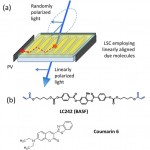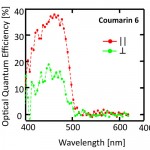Horizontal Dye Alignment in Luminescent Solar Concentrators for Energy-harvesting in Displays
Most modern displays enhance their contrast ratio using combinations of linear polarizers to absorb and dissipate incident light. The polarizers also absorb more than 50% of the light emitted from the backlight of the display, making them an extremely inefficient component of the modern displays. Thanks to their inherently absorptive surfaces and their ever-increasing sizes in televisions and mobile electronics, displays are interesting candidates for energy-harvesting. In this project, we test a new energy-harvesting strategy in which the purely absorptive polarizers in conventional displays are replaced with two linearly polarized luminescent concentrators (LP-LSCs) that channel the energy of absorbed photons to photovoltaics at the edge of the display.
Conventional polarizers are based on aligned molecules that are highly dichroic in their optical properties, i.e., they absorb light strongly when the E-field is oriented along their long axis while being relatively transparent to polarizations perpendicular to its natural dipole moment. Our idea is to introduce light-emitting molecules into the matrix of the polarizer so that absorbed photons are not merely dissipated as heat, but are re-emitted within a part of the polarizer that acts as a waveguide (see Figure 1a), just as in a conventional Luminescent Solar Concentrator [1]. These photons travel to the edges of the waveguide by total internal reflection, and they are collected by solar cells. This concept allows the photovoltaics to be located in the frame of the display, which minimizes their area, while leaving the entire front surface available for the display. We create such a linearly polarized LSC (LP-LSC) by using a polymerizable liquid-crystal matrix as a host so as to linearly align a rod-shaped dye molecule, such as Coumarin 6, in the plane of the substrate (Fig. 1b). Proof-of-concept experiments show that up to 38% of the photons polarized on the long axis of the Coumarin 6 dye molecules can be coupled to the edge of the device for an LP-LSC with an order parameter of 0.52 (Figure 2) [2].
- Figure 1: (a) A schematic representation of linearly polarized luminescent solar concentrators (LSC) for energy-harvesting in displays. (b) Chemical structures of the materials used for the linearly polarized LSC studies. The liquid crystal host material used is Paliocolor LC242. The dichroic dye molecule is 3-(2-Benzothiazolyl)-N,N-diethylumbelliferylamine (Coumarin 6).
- Figure 2: The optical quantum efficiency, defined as the fraction of the photons incident on the face of the luminescent concentrator that is emitted from the edge for a linearly aligned system. Only 70% of the incident photons were absorbed for this device.
References
- J.S. Batchelder, A.H. Zewail, and T. Cole, “Luminescent solar concentrators. 2: Experimental and theoretical analysis of their possible efficiencies,” Applied Optics, vol. 20, pp. 3733-3754, Nov. 1981. [↩]
- C. L. Mulder, P. D. Reusswig, A. P. Beyler, H. Kim, C. Rotschild, and M. A. Baldo, “Dye alignment in luminescent solar concentrators: II. Horizontal alignment for energy harvesting in linear polarizers,” Optics Express, accepted for publication. [↩]

